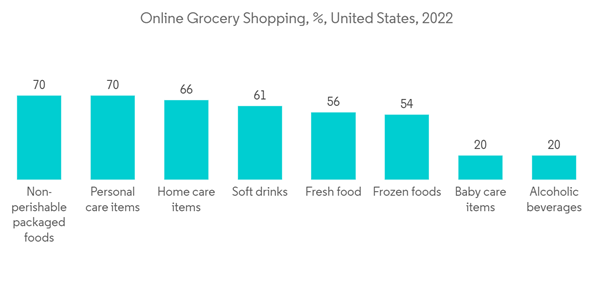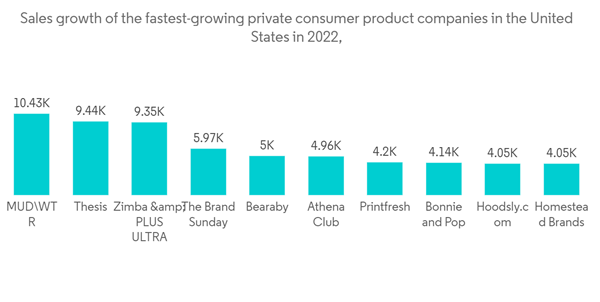Total e-commerce sales have grown by nearly 60 percent since the beginning of the pandemic, though penetration rates have leveled off. As such, consumers are increasingly seeking out one-stop shops and have expressed an interest in buying everything in one place, which will happen even more frequently in 2022. Meanwhile, the food-at-home market, which had been slowly losing share to food away from home before 2020, has surged 8.7 percent, four times its historical growth rate.
The move to eating food at home coincides with a growing emphasis on healthier eating. The FMCG sector has benefited from the current e-commerce growth. The industry is moving into a new era of supply chain management from traditional storekeeping, purchasing, materials management, and integrated materials management. FMCG companies often conduct their logistics operations using a hub-and-spoke model, with distribution hubs in important cities and towns serving both wholesalers and retailers. Customers anticipate quick order fulfillment via a variety of channels. Consumer goods firms outsource their logistics operations to do this by bridging the gap between operational and sales planning processes, enhancing forecasting, streamlining inventory, and accelerating delivery times.
Cold chain accounted for USD 248.4 billion in 2020 in the U.S. alone and is expected to exceed USD 410 billion by 2028. This growth has been driven partly by demand for healthier foods high in proteins, vitamins, minerals, and fats that must be transported within specific temperature windows. With labor shortages anticipated to continue throughout the supply chain, many cold chain companies are looking toward automated solutions. The pre-COVID Canadian cold storage landscape was growing, with trends in domestic and global food markets driving much of that demand.
North America Fast Moving Consumer Goods (FMCG) Logistics Market Trends
Increasing Growth in Food and Beverages Products are Driving the Market Growth
North American consumers are increasingly demanding fresh and healthy foods, which require specialized logistics capabilities to ensure that they are delivered to consumers in a timely and quality manner. This is driving demand for cold chain logistics, as many fresh and healthy foods must be kept at a specific temperature throughout the transportation and storage process. The e-commerce market for food and beverages is growing rapidly in North America. Experts predicts e-commerce will increase a modest 2.4 percentage points in United Staes over the next five years upto 2027, underscoring the challenges retailers face in balancing sales with profitability. The firms noted that health concerns from COVID-19 and other illnesses will likely continue to encourage online grocery shopping.The total number of households completing at least one order during the month of September 2023 jumped almost 11% compared to September 2022. The Supermarket monthly active user (MAU) base expanded by just under 1%, while the Mass MAU base, led by Walmart, surged 20% compared to 2022. The jump in total MAU base more than offset the order frequency decline and drove a nearly 2% gain in total order volume. Remote work is a key driver of food and grocery app adoption in Canada. The pandemic pushed more people to work from home, and the trend persists for many white-collar industries. Canada’s remote workers and students used food delivery apps and ordered groceries online in higher numbers. One of the largest national grocery chains, Metro, reported a surge in online activity in its fiscal Q1 2022.
The COVID-19 pandemic changed the behaviour of consumers in Mexico, as it did in other markets around the world. Limited access and mobility restrictions prompted consumers to test and adopt digital channels while reinforcing the importance of grocery retail as a primary source of basic food, beverages, and personal and home care supplies for households across the country.
United States Leading the market in North America
According to industry sources the FMCG e-commerce sales in the United States are expected to reach USD 1.6 trillion by 2025. This growth is driving demand for more efficient and reliable FMCG logistics solutions. Consumers are increasingly demanding fresh and perishable products, which require specialized logistics solutions to ensure that they are delivered to customers in a timely and safe manner. The disposable income of US consumers has been rising steadily in recent years. This is giving consumers more money to spend on FMCG products. In 2022, the national per capita disposable personal income was USD 55,832. For example, sales of organic food in the US are expected to reach USD 100 billion by 2025.The US population is becoming more diverse and aging. This is creating new opportunities for FMCG companies to develop products that meet the needs of these changing demographics. The United States had an official estimated resident population of 333,287,557 on July 1, 2022, according to the U.S. Census Bureau. The growing Hispanic population in the US is driving demand for Hispanic inspired foods and beverages. For example, Sales of salsa in the US have increased by 50% in the past decade.
E-commerce is growing rapidly in the US. This makes it easier for consumers to purchase FMCG products and is also driving growth in new categories such as online grocery delivery. In addition, personal care products are in high demand, especially among millennials and Gen Z consumers. This is driving the growth in the FMCG logistics market, as logistics providers need to be able to efficiently transport and deliver these products to consumers. For instance, UPS has partnered with Unilever to launch a new dedicated logistics service for personal care products. The service will use temperature-controlled vehicles and warehouses to ensure that Unilever’s personal care products are delivered to customers in a safe and fresh condition
North America Fast Moving Consumer Goods (FMCG) Logistics Industry Overview
The report focuses on the key players in the North American FMCG Logistics Market. The market is highly competitive, with many local and international players. The opportunity for FMCG logistics service providers has increased due to COVID's impact and is expected to continue in the coming years. Some of the major players in the FMCG logistics market include DHL Group, C.H. Robinson Worldwide Inc., Kuehne + Nagel, Agility Logistics, CEVA Logistics, and FedEx, among others.Additional Benefits:
- The market estimate (ME) sheet in Excel format
- 3 months of analyst support
This product will be delivered within 2 business days.










